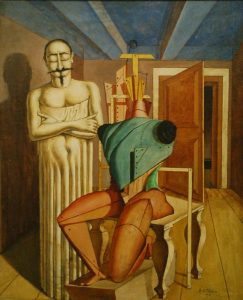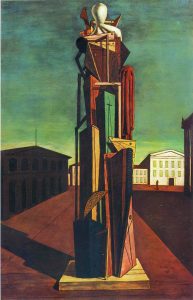Metaphysical Art (the translation of the Italian Pittura Metafisica) was an early twentieth century Italian art movement developed by Giorgio de Chirico and Carlo Carrà represented by unexpected imagery to produce disquieting effects on the viewer.

Image source: https://search.creativecommons.org/photos/48cbab4d-cc89-4955-9033-4ffe7beeb0e8 Author: Tulip Hysteria / Go to albums
Metaphysical Art is a movement created by Giorgio de Chirico and the former futurist, Carlo Carrà, in the north Italian city of Ferrara. Using a realist style, they painted the squares typical of such Italian cities but the squares are unnaturally empty, and in them objects and statues are brought together in strange juxtapositions. The artists thus created a visionary world of the mind, beyond physical reality – hence the name.
What is Pittura Metafisica?

Image source: https://search.creativecommons.org/photos/c040b715-5e05-4e9f-b2ee-b9997d89e6da Author: La case photo de Got
The brief analysis of the painting is generally applicable to the very concept of Pittura Metafisica. The idea behind it relies on a supposition, or rather a decision, that the physical world is not presenting reality as it is. Therefore, we need to consider more than just the figurative and more than the bodily, to understand “that which cannot be seen”. Ultimately, this renders Metaphysical Art as a movement that refers to “The All”, a unity of all aspects of being. Strinati even relates the momentum of Pittura Metafisica’s conception to de Chirico’s physical state, since it was a period of time in which he was recovering from an illness, and therefore aiming to reconcile his body, spirit and soul and to achieve the harmony of being.
What influenced Metaphysical art?

Image source: https://search.creativecommons.org/photos/a8c966dc-7db9-4a3f-a6f6-746b49bd04e9 Author: Tulip Hysteria / Go to albums
Giorgio de Chirico, unlike many artists of his generation, found little to admire in the works of Cézanne and other French modernists, but was inspired by the paintings of the Swiss Symbolist Arnold Böcklin and the work of German artists such as Max Klinger. His painting The Enigma of an Autumn Afternoon (c. 1910) is considered his first Metaphysical work; it was inspired by what de Chirico called a “revelation” that he experienced in Piazza Santa Croce in Florence. In subsequent works he developed a disquieting imagery of deserted squares, often bordered by steeply receding arcades shown in a raking light. Tiny figures in the distance cast long shadows, or in place of figures there are featureless dressmakers’ mannequins. The effect was to produce a sense of dislocation in time and space.
The short history of Metaphysical art

Strictly speaking the movement only lasted the six months or so of 1917 that De Chirico and Carra worked together, De Chirico changing his style the following year. However the term is generally applied to all De Chirico’s work from about 1911 when he first developed what became known as Pittura Metafisica. His The Uncertainty of the Poet of 1913 is a quintessential example of the style. Pittura Metafisica was also highly influential, most importantly on the development of the dream-like, or oneiric, kind of surrealist painting, particularly that of Max Ernst.
Metafisica interpreted by the design studio MILO

Type: Set Design & Styling
Status: completed February 2017
Image source: http://www.studio-milo.com/
Valdama, a made in Italy company specializing in bathrooms design, has appointed Studio MILO to create the set design for its 2017 advertising campaign. Taking inspiration from the era of surrealism, the set reflects the notion of a theatrical backdrop where mirrors, ladders and curtains create an artificial illusion of hanging and flying objects – the products. Lighting, geometrical forms and dark tones are used to make the products the unspoken yet undisputed protagonists.
Info source:
https://en.wikipedia.org/wiki/Metaphysical_art https://www.tate.org.uk/art/art-terms/m/metaphysical-art https://www.britannica.com/art/Metaphysical-painting http://www.studio-milo.com/studio-milo/sogno-artificio-e-metafisica/
